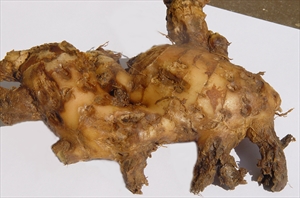- Worldwide distribution. In tropics and sub-tropics. The nematode has a large host range, including: banana (see Fact Sheet no. 257), betel nut, black pepper, coconut, coffee, giant swamp taro (see Fact Sheet no. 203), and tea. An important disease.
- Nematodes enter roots and young rhizomes, killing the roots, and causing brown sunken areas on rhizome that later join together. Leaves are yellow, stunted and die early.
- Spread is in soil water, soil on footwear, machinery, and in rhizomes used for planting.
- Yield losses of 40%, and damage continues in storage.
- Cultural control: clean 'seed' from healthy crops; treat seed with hot water (51°C for 10 mins.); apply manures; weed; 3-4-year crop rotation.
- Chemical control: none recommended.





